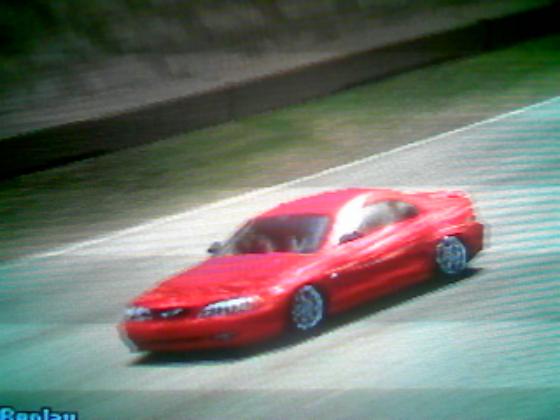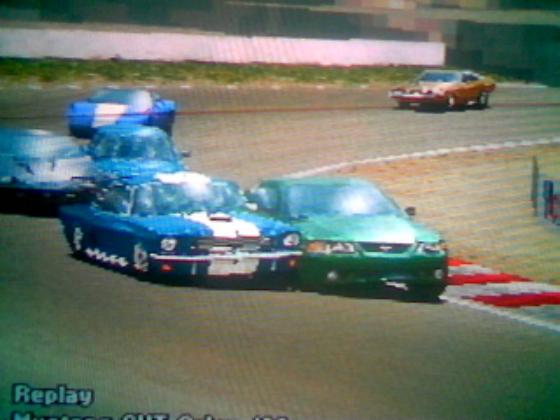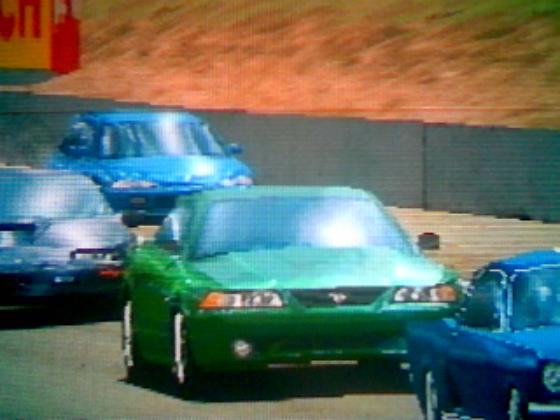|
Year: 1998-1999
Class: Pony Car / Muscle Car
Type: 2+2 Coupe
Country: USA
Host: GT2
Price: $17,290 (1998) $17,480 (1999)
Length: 181.5" // Width:
72" // Height: 53"
Wheelbase: 101.3"
Overhang: @6 feet 7 inches
Track: 60.5" [F] 59.2" [R]
Ground Clearance:
6.3"
Weight: 3,278 pounds (1998) 3,273 pounds (1999)
Tires: 225/55ZR-16
Brakes:
vented discs
F. Suspension: MacPherson strut/ coils/ anti-roll bar
R. Suspension: live axle /coils
Engine: 280 cubic-inch SOHC V8
Tested HP: ``210 @ 4,400 rpm
Tstd Torque: 290 @ 3,300
rpm
Lbs. per HP: 15.6
HP per Liter: 45.65
Credits per HP: $82.93
Aspiration: normal
Fuel System: 2-barrel carb.
Layout: Front Engine / Rear Drive
Valves per Cylinder: 2
Bore
x Stroke: 3.54 x 3.54"
Compression: ?
Redline: 5,500 // Rev Limit: 7,000
Transmission: 5-speed manual
0-60 mph: 6.6 seconds
0-100mph: 17.9 seconds
400 M: 15.247 @ 92 mph
1 KM: 27.736 @ 120
mph
Test Track: 1:51.936
Top Speed: 154.15 mph (4,550 rpm in 5th gear)

-----------------------EXTERIOR-----------------------
Unlike the Mercury Cougar, Buick Regal, Buick Skylark, Chevy Monté Carlo, Oldsmobile Cutlass, and
countless others, the Mustang has stayed true to its roots and remains a rear-wheel drive car to this day.
Some may
have forgotten those terrible weeks back in the early '80s when there were rumors that the Ford Mustang, Chevy Camaro,
and Pontiac Firebird would all become front-drive cars, so it's nice to see that Ford and GM haven't disappointed
their customers.
The Mustang is one of the cars many of us felt was missing from GT1. Well, okay....some
of us did. Those of us who wanted to perform the classic American battle: Mustang versus Camaro did. But
there were no Fords (and hence, no Mustangs) in the first Gran Turismo. Well now here it is in GT2 -- here is our big
chance to see once and for all who is boss!
Like the Camaro Z/28, the Mustang GT is affordable, fast, and
can be made to go even faster, though it does just fine at most lower B and A-license races...lightly modified
right off the dealer's lot. There are four versions of the 3rd generation Mustang represented in GT2, and unfortunately,
they are only a year apart from one another as far as their model years are concerned. This sucks and is not acceptable.
Between these 'stangs and the Shelbys from the '60s, there happens to be a HUGE gap of history here. Hello???
This
version (the GT) has the least power, so the main reason anyone would want to buy it (in my opinion) is it can be entered
into a lot of the horsepower limited races, including the Trail Mountain Endurance, Compact Car series, and so on.
3rd
generation 'Stangs have lasted for years with pretty much the same looks. In 1979, the ugly and under-powered Mustang II ended
a 5-year production run that wasn't going anywhere. Unfortunately, the new Mustang which followed looked even tamer
than than the Mustang II, and still had a sucky, under-powered engine. But by 1983 or so, Ford was putting
more energy into making the 3rd-generation Mustangs look aggressively ugly, just like some of the earliest versions...which
is what Mustang customers like. Since then, the car hadn't had a major facelift, but in my opinion it could have used one.
In GT2, a new GT from either 1998 or 1999 costs just over $17,000, which is approximately $11,000
less than the more-powerful SVT Cobra from either year (also found in GT2). The lower cost is not an indication of less performance,
however. The GT weighs in at almost 3,300 pounds, which is around 150 less than the Cobra, and this can be further reduced
to around 2,900 lbs. with full weight reductions.
Mustangs from these years all have the same 101" wheelbase, which
translates to about 80 inches of overhang...approximately 16 less than the Camaro. Therefore, the Mustang is a bit easier
to maneuver since there is less weight being slung around. One of my only criticisms is that we can't buy the full
racing body for this car. For this: we'll need the Cobra. This will only be a problem for those buying Mustang GTs
who aren't aware of this discrephancy. Imagine getting one and putting lots of money into its development, only to find
we can't go "all the way" with it, and need to get a different car! Ooops.

|
| '66 and '99 'Stangs battle at Laguna Seca |
------------------ENGINE / DRIVETRAIN-----------------
Here we have Ford's 280 cubic inch SOHC V8 engine, which after all these years still has
a 2-barrel carburetor instead of a more efficient fuel-injection system. Woulda been nice if PD
had put an earlier 3rd gen Mustang 5.0 from the '80s or early '90s, but whatever. Anyways, the engine
is considered a small-block, and is predictably mid-rangey with its power.
The 1998 model has 210
tested horsepower (224 quoted), wheras the '99 has 260 quoted horsepower,
but tests at just 210 at the track! Weird. Either engine can handle 3 stages of NA tuning, which
are costly, but supply a lot of energy. Ultimately, the Cobra is the car that REALLY gets the power, of course, but the '98
GT's 377hp @ 5,100 rpms and 410 ft-lbs. of torque at 4,200
isn't bad, and the '99 car will go even higher.
0-60 mph and 0-100 are achieved in 6.6 and 17.9
seconds (in the '98 GT) and the quarter-mile was passed in just over 15 @ 92 mph. If anything,
Mustang GTs are consistent in the acceleration department. The car's top speed of 154.15 mph doesn't
hurt, either. The 5,500 rpm redline seems rather low, but remember that the powerband starts at around 3,500 rpm, peaking
at 5,000. This is a V8, not a fuel-sipping 4-banger.
The engine note is lame. Really, this is the biggest disappointment
about the GT. Real Mustangs (GTs or Cobras) tend to have a bassy, hollow-sounding exhaust that is missing from the game GT.
And it's not just the fact that this is a video game either. The '99 Mercury Cougar, for instance, has a growl to it that
I expected to hear from the Mustang GT as well, but it just isn't there. Not till the car has at least a Stage 2 NA tune with
stock exhaust, anyways. Again, the Cobra is exempt from this disappoinment, and sounds more threatening.
Threatening...what
a good word. ;)

---------------------CHASSIS / HANDLING-----------------
If it ain't broke, don't fix it. That's the motto here!
In this day of multi-link, electronically
controlled suspensions with "sport" and "comfort" modes, 4-wheel computerized steering, wheel-spin detectors, and traction
controls, the Mustang's MacPherson Struts up front and live rear axle in the rear (with no sign of any electronic aids whatsoever) may
seem outdated and archaic. For instance, even 4th generation Camaro got traction control eventually. The Mustang's basic
design (independent front struts and live rear axle) hasn't changed since the late '70s, when Mustang dropped rear leaf
springs and went with coils, but kept the live rear axle to appease fans of true pony-car performance (and save a bit
of money at the production lines).
What does this mean? It means that the Mustang won't be a smooth riding car all
the time; that rear axle will buck and skip under pressure (hence, the term 'pony car'), but it is made to handle enormous
amounts of torque. This set-up was made to win back then, and it still does now.
The front engine/rear drive layout
makes this car a blast for drift-lovers. Standard spring rates of 2.5 kg/mm front and 2.0 rear are a lot lower than I expected,
so before we touch the engine, it's a good idea to stiffen up the suspension first. The easily-bought semi-racing underparts
will do the trick just fine unless there's money for full-racing parts. Since the GT can't accept a racing body, the racing
suspension isn't really all that pertinent.
The main difference between the '98 and '99 models here is that the latter
year features a slightly wider track to enhance stability, as well as an independent rear suspension in the '99 GT (no more
live axle). Is there truely a difference? I truely can't notice it. My friend Sucahyo couldn't find any difference when looking
at computer coding between 1998 and 1999 Mustangs in GT2, either. Odd that PD even included this small difference in
model years. My theory is somebody over there had the original intention of making the 4th-gen 'Stang with the live axle,
and then without it, but that "somebody" wound up dropping the ball as GT2 was rushed to production.
Either year can
also be enhanced with a limited-slip differential, which makes things more predictable and fun for drifting. These cars
are loaded with 225/55-16" tires front and rear, providing plenty of grip for those wanting to experiment with power-slides,
oversteer, and the like. Sport tires can be relied upon till one gets above full Stage 1 tuning if experienced with Gran Turismo.
Overall, GT2 is the only game to feature "standard" Mustangs from the 4th-gen era, rather than just featuring the
red Cobra R, as GT3 and GT4 do. So for those of us who are major 'Stang lovers (myself included), there are way more
questions than answers.
-------------------PROS---------------------------
1). Great performance for relatively very few credits. Credit per HP ratio of $82.93 is hard to beat.
2). 2-barrel
carb, live rear axle, rear drive. This car refuses to compromise with modern times, yet it still kicks some ass.
3).
Tires provide both grip and drift ability. Sports go a long way; can be used reliably even after Stage 2 tuning is applied.
4). Good power is standard and can be made even better.
5). The fact that the GT isn't as strong as the Cobra
means it can be entered into more lower-powered GT2 events.
----------------CONS----------------
1). Outdated styling and body-work. Many don't like the 'Stang for this reason.
2). Heavy car that doesn't get
much below 3,000 pounds, even with full weight reductions. No racing kit, either.
3). Stock exhuast / engine sample
sounds rather lame for a V8. The SVT Cobra sounds more realistic.
4). Mushy springs standard. The Mustang GT only starts
to shine with a better suspension.
5). The gearing is a bit tall; 2nd & 3rd gear acceleration feels tepid.
6).
Why why why are there VERY SIMILAR years represented in GT2? One's cheaper than the other....big deal. The main real-life
difference (live rear axle followed by an independent rear) isn't obvious in the game. Grrrr....
Published: May 25th, 2004
|

